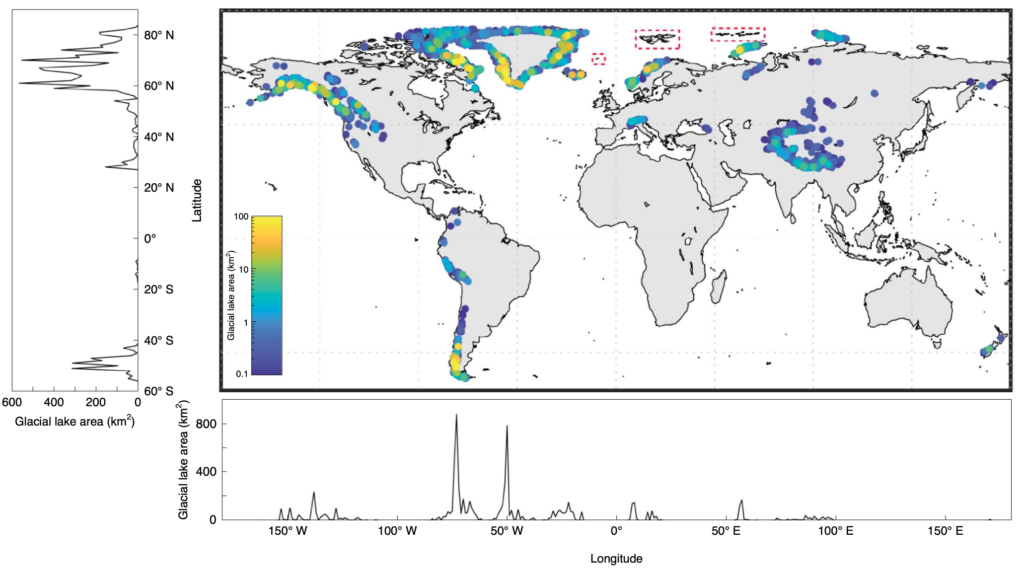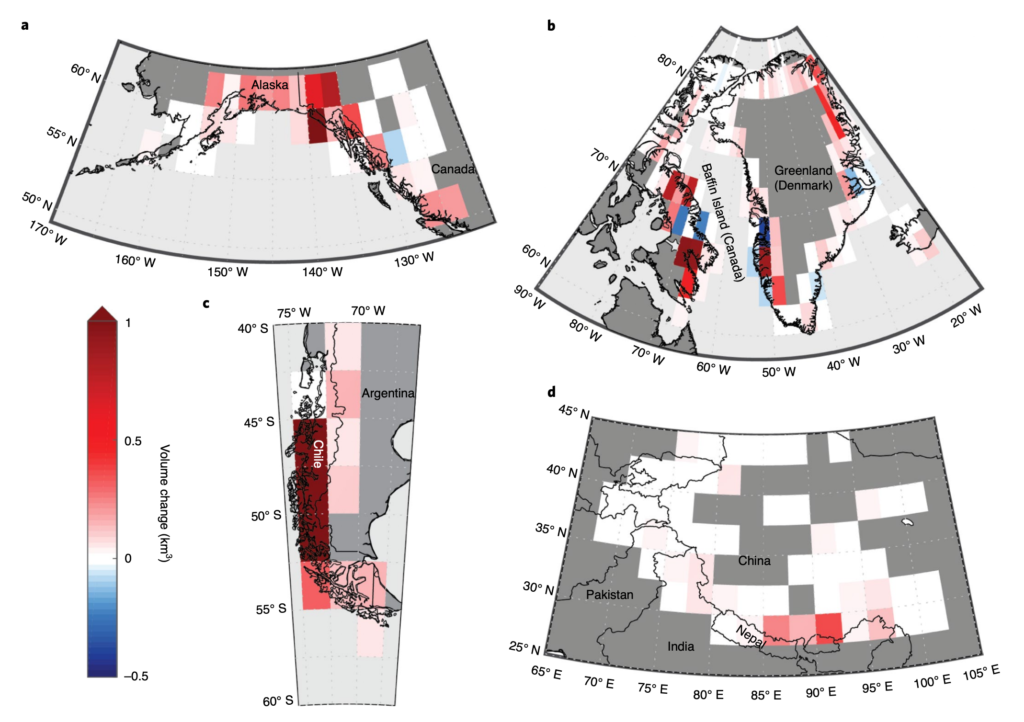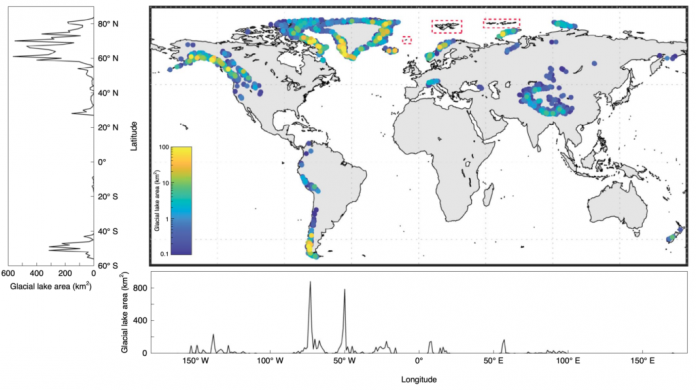Lakes formed by melting glaciers around the world have increased in size by 50% over the past 30 years.
That is the main finding of our new study, published in Nature Climate Change, which provides yet another sign of a warming climate – and one that affects water supplies and flood risk for billions of people.
Glacier melting in recent decades has led to a dramatic increase in the size and number of glacial lakes. These form behind natural dams created by debris pushed along at the front of glaciers and left behind as glacier fronts retreat.
Until now there has been no global assessment of the number of glacial lakes, nor of how they have changed over time.
However, “big data” cloud computing now lets us use automated mapping with vast archives of satellite imagery. In our new study, we have produced the first global dataset of changes in glacial lakes in response to climate change and other drivers.
Glacial lakes
As glaciers around the world respond to a warming climate, melting ice is driving the growth of glacial lakes. These lakes take various forms and can themselves speed up ice loss and retreat of glaciers.
The map below shows the distribution of these lakes across the world. The dots show their locations and the colour indicates size – from small (around 0.1 square kilometres, km2) in blue to large (around 100km2) in yellow.

Glaciers act as “water towers” that provide a reliable water supply to communities living downstream. Thus, their ongoing transformation into glacial lakes is an important factor for changing water storage resources in mountain areas, which 1.9 billion people rely on.
Melting glaciers are also contributing to sea level rise, but meltwater does not always flow straight into the sea if some of it is held back in glacial lakes and groundwater. The amount of glacial meltwater held in lakes was highlighted as a key knowledge gap in the most recent assessment report from the Intergovernmental Panel on Climate Change (IPCC).
In addition, glacial lakes are the source of potentially catastrophic outburst floods, known as glacial lake outburst floods (GLOFs). These are generally considered to be the largest and most extensive glacial hazard in terms of disaster and damage potential – particularly in many developing countries throughout South America, the Himalayas and other parts of Central Asia.
The video below, produced by NASA, summarises the findings of our study.
Using satellite data to track glacial lakes changes
To assess changes in glacial lakes around the world, we used more than a quarter of a million images taken by the NASA Landsat satellites between 1990 and 2018.
We then created a model in the Google Earth Engine that identifies and outlines bodies of water on the Earth’s surface and picks out those linked to glaciers. We focused on lakes with an area of at least 0.05km2.
From this we used statistical relationships to estimate total lake volume and narrow down how this has changed over recent decades, and how global sea level is affected.
Back in the 1990s, 9,414 glacial lakes covered almost 6,000 km2 of the Earth’s surface and collectively contained around 106 cubic kilometres (km3) of water. But by 2015-18, the number of glacial lakes worldwide increased by 53% to 14,393. The total lake area increased by 51% to almost 9,000 km2.
The figure below shows the changes in glacial lakes in a) Alaska and western Canada, b) Greenland and the eastern Canadian Arctic, c) Patagonia, and d) the Himalayas. Red shading indicates lakes that have increased in volume, while blue shows those that have decreased.

The total volume of the lakes increased by 48% to 157 km3. In some regions, such as the Himalayas, the changes were large enough to be a significant part of the water cycle. This extra meltwater would have otherwise contributed to sea level rise, unless it had drained into groundwater or evaporated. This would have increased global average sea level rise by 0.14mm. The total amount of water stored in the lakes we mapped would increase sea level by 0.48mm. While these amounts are small, its value was previously not known at all, so we have helped to reduce uncertainties in the calculations of global sea level rise.
Although, generally, mountain glacier lakes grow as glaciers retreat, we do not see this everywhere. For example, along the edge of the Greenland Ice Sheet many ice-dammed lakes drained as ice retreated. This counterintuitive behaviour is explained by the subdued terrain surrounding much of the ice sheet.
Outside of Greenland, the estimated volume of lakes associated with mountain glaciers increased by more than two-thirds from 68km3 to 114 km3.
Links to climate change
The simplest explanation for the rapid worldwide increase in the number, area and volume of glacial lakes since the 1990s is human-caused global warming. And the fact that lakes have grown fastest at very high latitudes is consistent with our understanding of Arctic amplification, where the Arctic has warmed up to three times more quickly than the global average.
However, it is worth noting that some of the changes may be due to natural climate variability. The global pattern of glacial lake development is complex and, as a result, simple climate change attribution is likely to be difficult at both regional and global scales.
Our work also provides insight into the timing of GLOFs. Scientists can estimate the timing of peak GLOF risk from certain glacial lakes. This requires assessing the lag times that exist in glacial-lake systems between a change in climate – such as a warming or drying trend – and glacier recession, lake development and GLOF trigger.
Our new results represent the first two stages in this process – glacier recession and glacial lake expansion – as glacial systems prepare for a probable future rise in GLOFs.
The enhanced GLOF risk is greatest in countries that rely on glacier melt for hydropower development, or where the early stages of economic development still leave many people exposed to GLOFs and their effects.
In Nepal, for example, many hydropower plants exist or are being built very close to glacier termini or glacial lakes in valleys that have recently experienced outburst floods. And it has been estimated that the costs associated with the destruction of a mature single hydropower installation by an outburst flood could be hundreds of millions of dollars (pdf).
On the other hand, basins that have lost their glaciers may prove important storage basins for hydropower development.
We expect that the number and size of lakes formed by glacial meltwater will continue to increase in a warming world – and this may even accelerate. However, not all glacial lakes will continue to grow at rates we observed over the past quarter century.
Some – especially small lakes – may grow more rapidly, while others will no doubt grow more slowly, especially those which lose a close connection with their glaciers as they retreat. Others will drain or gradually fill with sediment, or their growth will be stabilised by direct human intervention.
Our estimates of lake volume changes fill an important knowledge gap in the sea level budget and, hence, help to further increase confidence in understanding and predicting ongoing sea level rise. They will also help in future assessments of glacial hazard risk.
The post Guest post: How climate change is turning glaciers into lakes appeared first on Carbon Brief.











